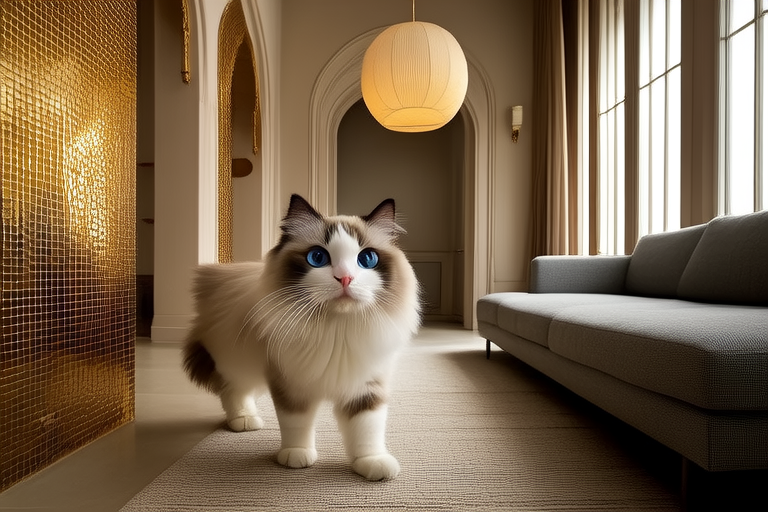From Persian Palaces to Modern Homes: The Journey of Ragdolls
The term “Ragdoll” evokes images of elegance, grace, and an almost otherworldly calmness. Known for their docile nature and striking appearance, these cats have captured the hearts of many. With their semi-longhair coats, blue eyes, and distinctive color points, Ragdolls are unmistakable. They are not just pets; they are companions that bring a serene touch to any household.
Unique Characteristics of Ragdolls
Ragdolls are renowned for their placid demeanor, which is why they are often referred to as “dog-like” cats. When picked up, they tend to go limp, giving them their name. Their large, round eyes and plush coats make them look like living toys, but it is their temperament that truly sets them apart. These felines are incredibly gentle, making them ideal for families with children or other pets.
Their coat comes in various colors, including seal, chocolate, blue, and lilac, with points that can be solid, lynx, or tabby patterns. Their coats are semi-long, requiring regular grooming to prevent matting. Despite their long fur, Ragdolls are relatively low-maintenance when it comes to shedding, thanks to their dense undercoat.
Origins and Development of Ragdolls
The story of the Ragdoll begins in the early 1960s in Riverside, California, where Ann Baker, a breeder and owner of a cat colony, developed the breed. The breed’s foundation was laid by Josephine, a white domestic longhair with a mix of Siamese traits. Josephine was involved in an accident, and after her recovery, she produced kittens with distinct traits. Ann recognized the uniqueness of these kittens and began a systematic breeding program.
Ann Baker’s breeding efforts led to the creation of the first Ragdoll breed standard. She registered the breed with the International Cat Association (TICA) in 1973. However, due to disputes over ownership and breeding rights, the breed was also registered with the American Cat Fanciers Association (ACFA). This dual registration has contributed to the breed’s widespread recognition.
Gaining Recognition and Global Popularity
Ragdolls transitioned from home breeding to gaining recognition in cat shows during the 1970s. Their striking appearance and docile nature made them popular among cat enthusiasts. The breed’s acceptance into cat shows marked the beginning of its journey to global recognition.
Today, Ragdolls are one of the most popular breeds globally. Their appeal lies in their affectionate nature and adaptability to different environments. They are often seen as the perfect companion for people looking for a pet that is both beautiful and easygoing.
Reasons Behind Their Affectionate Reputation
The primary reason behind Ragdolls’ affectionate reputation is their docile nature. Unlike some breeds that are more independent or aloof, Ragdolls thrive on human interaction. They enjoy being petted, cuddled, and even carried around. Their loyalty and attachment to their owners make them excellent companions.
Ragdolls are also known for their playful nature, especially during their younger years. They enjoy playing with toys and engaging in activities that stimulate their minds and bodies. Their intelligence makes them quick learners, and they can be trained to follow simple commands, such as fetching toys or walking on a leash.
Tips for Potential Owners
If you’re considering bringing a Ragdoll into your home, there are several factors to consider. First, ensure you have the time and resources to provide proper care. Ragdolls require regular grooming to keep their coats healthy and free from mats. They also need a balanced diet rich in protein to support their muscle development and overall health.
Ragdolls are social animals and thrive in environments where they receive plenty of attention. If you work long hours or are away frequently, consider adopting two Ragdolls so they can keep each other company. Additionally, providing them with interactive toys and playtime can help stimulate their minds and keep them happy.
Future Prospects and Health Considerations
The future of Ragdolls looks promising, with continued advancements in breeding and genetic health considerations. Breeders are focusing on maintaining the breed’s unique characteristics while addressing common health issues. Conditions such as hypertrophic cardiomyopathy (HCM), polycystic kidney disease (PKD), and progressive retinal atrophy (PRA) are prevalent in the breed, and responsible breeding practices are crucial to reducing their incidence.
Ongoing research and genetic testing are helping breeders identify carriers of these conditions, allowing for more informed breeding decisions. As awareness grows, potential owners can seek out reputable breeders who prioritize the health and well-being of their cats.
Conclusion
From their humble beginnings in a cat colony in California to becoming beloved pets worldwide, Ragdolls have come a long way. Their journey reflects the enduring appeal of these gentle giants. Whether you’re a seasoned cat lover or new to the world of feline companionship, a Ragdoll could be the perfect addition to your family.
As we look to the future, the ongoing advancements in breeding and health management will ensure that Ragdolls continue to thrive. By understanding their unique needs and providing them with love and care, we can ensure that these magnificent creatures remain cherished companions for generations to come.
